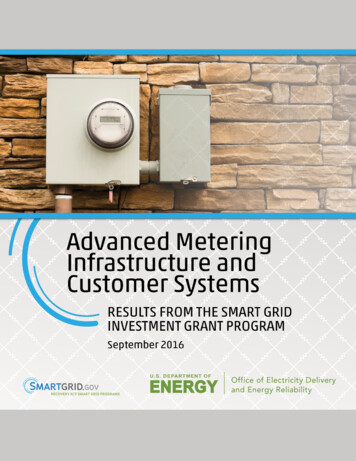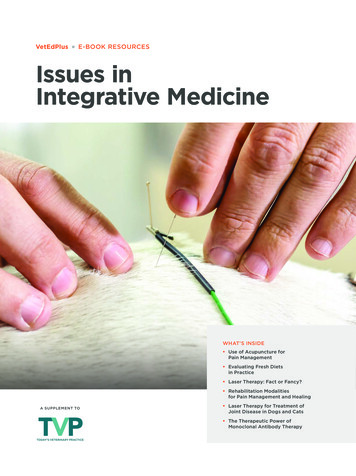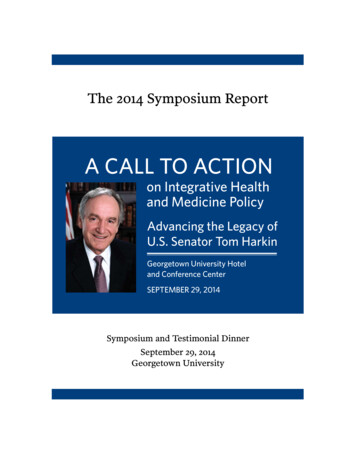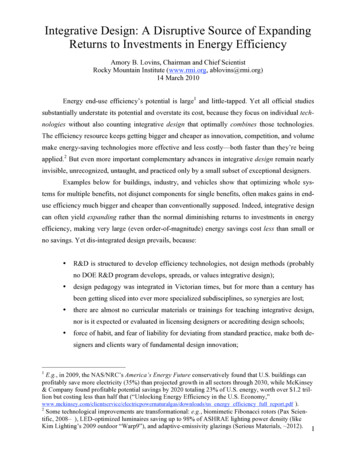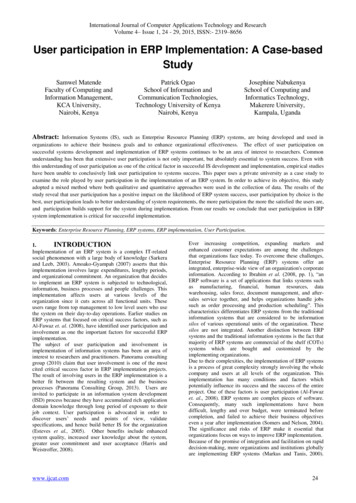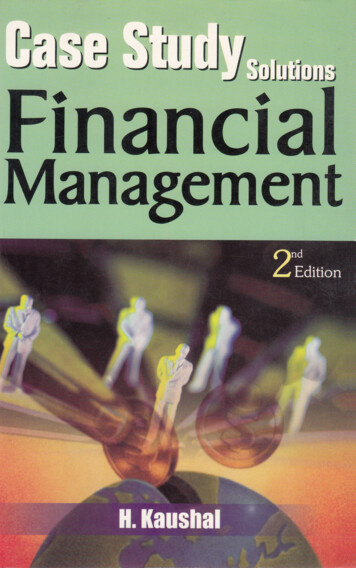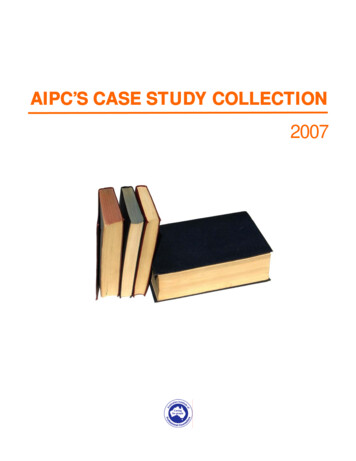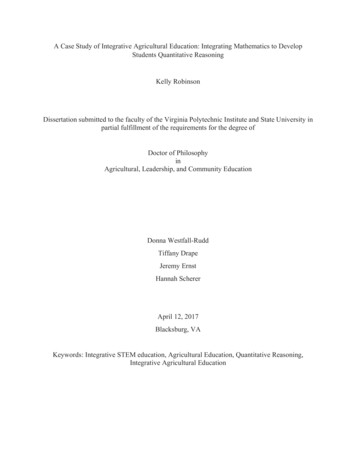
Transcription
A Case Study of Integrative Agricultural Education: Integrating Mathematics to DevelopStudents Quantitative ReasoningKelly RobinsonDissertation submitted to the faculty of the Virginia Polytechnic Institute and State University inpartial fulfillment of the requirements for the degree ofDoctor of PhilosophyinAgricultural, Leadership, and Community EducationDonna Westfall-RuddTiffany DrapeJeremy ErnstHannah SchererApril 12, 2017Blacksburg, VAKeywords: Integrative STEM education, Agricultural Education, Quantitative Reasoning,Integrative Agricultural Education
A Case Study of Integrative Agricultural Education: Integrating Mathematics to DevelopStudents Quantitative ReasoningKelly RobinsonAbstract (Academic)Preparing students to be life-long learners that are career and college ready is a goal ofagricultural education. Changing expectations of education have pointed to agriculture educatorsas potential leaders in the STEM education movement. Literature related to STEM education inagricultural education is lacking in guidance for teachers, administrators, and curriculumdevelopers in integrating academic content related to STEM content areas. A review of STEMeducation literature coupled with the framework of quantitative reasoning, lead to aconceptualization of a framework for integrative agricultural education. This framework wasimplemented through a case study to investigate collaborative efforts in curriculum developmentin agricultural education with a specific focus on integrating mathematics to develop students’quantitative reasoning skills. Teacher characteristics were identified that seemed to supportimplementation of integrative agricultural education practices. Teaching and planning strategieswere also identified in the case study. Recommendations suggest support of collaborationbetween agriculture and mathematics teachers would best support curriculum design and aid inthe quality of instruction that follows.
A Case Study of Integrative Agricultural Education: Integrating Mathematics to DevelopStudents Quantitative ReasoningKelly RobinsonGeneral Audience AbstractAgricultural education teachers work to prepare students to be life-long learners that arecareer and college ready. STEM education has become vogue in education. As expectationschange about what students should learn and how they learn it, agriculture educators havepotential to be leaders in the STEM movement. STEM education in agricultural education islacking in guidance for teachers, administrators, and curriculum developers in integratingacademic content related to STEM content areas. This dissertation presents a conceptualizationof a framework for integrative agricultural education that combines elements characteristic ofSTEM education coupled with the concept of quantitative reasoning. The framework was usedto research collaborative efforts in curriculum development in agricultural education with aspecific focus on integrating mathematics to develop students’ quantitative reasoning skills.Results provide teacher characteristics that seemed to support implementation of integrativeagricultural education practices. Teaching and planning strategies were also identified that leadto recommendations suggesting support of collaboration between agriculture and mathematicsteachers would best support curriculum design and aid in the quality of instruction that follows.
Table of ContentsAbstract (Academic) . iiGeneral Audience Abstract . iiiTable of Contents . ivList of Tables . viList of Figures . viiIntroduction . 1References . 3Conceptualizing Integrative Agricultural Education: An Introductory Framework for IntegratingMathematics in Agricultural Curriculum . 5Abstract . 5Process of Review . 8Review of Literature on Integrative Teaching . 8Integrative Instruction . 9Authenticity . 10Critical Thinking & Problem Solving . 10Student Centered Learning . 11Technology . 12Quantitative Reasoning . 13Agricultural Education as Context for Learning Academic Content . 15Mathematics in Agricultural Education . 16Conceptualizing Integrative Agricultural Education. 17Meeting Standards Through Context . 17Building Literacy Through Experiences . 19Authenticity in Agricultural Education. . 20Student Centered Learning in Agricultural Education. . 20Critical Thinking & Problem Solving in Agricultural Education. 22Teaching for 21st Century Skills in Agricultural Education . 23Implications of IAE . 24Tools for Teachers . 25Conclusion. 26References . 26Launching the Conversation of Integrative Agricultural Education: A Case Study IntegratingMath in Ag Ed to Develop Students’ Quantitative Reasoning . 33
Abstract . 33Purpose . 36Research Questions . 36Method . 37Research Design . 37Identifying the data . 39Rationale for the Case Study Design . 40Researcher Subjectivity . 41Conceptual Framework . 41Significance of the Study . 43Results . 44Integrative Agricultural Education Rubric . 44Collaboration . 47Instructional activities. 49Planning, Teaching, & Reflection . 56Discussion . 64Implications . 69Conclusion. 71References . 73Appendix . 80IAE Rubric & Rubric Scoring Explanations . 80
Table 1Table 2Table 3Table 4Table 5Table 6 List of TablesThe Goals and Objectives of Integrative Agricultural Education. 18 Goals and Objectives of Integrative Agricultural Education Framework . 42 IAE Rubric Scores for Written Integrative Lesson Plans . 45 Break-out Rubric Scores for IAE Components . 46 IAE rubric scores for implemented activities . 50 Break-out Rubric Scores for IAE Components in Implemented Activities. 51
List of FiguresFigure 1 Four Stages of Research, Analysis, and Research Artifacts . 39
* IntroductionAgricultural education teachers report attempts of integration in science, math, andSTEM content areas (Blum, 1996; Stubbs & Myers, 2015; The National Council for AgriculturalEducation, 2015) but also expressed a desire to have more training in integrating academicconcepts (Anderson & Anderson, 2012; Balschweid & Thompson, 2002; Thompson &Balschweid, 2000). These and other agricultural education teachers have also expressed a desireto have an academically integrated agricultural education curriculum that can be implemented intheir classrooms (Anderson & Anderson, 2012; Asunda, 2012; Balschweid & Thompson, 2002).Stone (2008) set forth the framework for Math-in-CTE which provided a building block to beginformulating a framework that pulls together specific aspects of integrative teaching practices andfocusing on math integration in agricultural education. A curriculum framework based on recentliterature related to integrative instructional practices would update Stone’s (2008) Math-in-CTEmodel and connect pedagogy to STEM education practices which are strong in integratingscience, technology, engineering, and mathematics.Agriculture educators are in a position to support students’ academic literacy whilepreparing them to be life-long learners and critical thinkers. Federal funding calls for a balancebetween academic integration and career and college readiness in career and technical education(Phipps et al., 2008). The National Council of Teachers of Mathematics (NCTM) lays thefoundation for standards in math education grounded in application in a context (1989, 2000).Combining the governmental goals and the national mathematics standards, opens the door forstudents to develop quantitative reasoning (QR) skills. Quantitative reasoning is the ability toapply mathematical knowledge to complex situations and reason through the context of theproblem confidently and with a mathematical eye (Steen, 1997, 2004). Quantitative reasoningalso falls within the skill set described as 21st century skills (Partnership for 21st Century
Learning, 2015). The National Research Council (2011) suggests that 21st century skills are bestlearned in a broad context to practice complex problem solving and critical thinking.While agriculture educators are approached to include STEM content in their curriculumto support students’ 21st century skill development and academic knowledge, there is a notablelack of support on what a STEM infused curriculum should look like in agricultural education(Scherer, et al., 2017). Teachers reportedly requested an integrative curriculum in agriculturaleducation they could use in their classrooms (Anderson & Anderson, 2012; Asunda, 2012;Balschweid & Thompson, 2002). The first manuscript includes a conceptualized curriculumframework for integrative agricultural education (IAE). This is not the classroom readycurriculum teachers requested but a significant start on the development of that curriculum.The IAE framework provided guidance to a case study agriculture teacher and me duringcollaborative curriculum development in an Introduction to Animal Sciences course. Theinstructional unit developed was designed to integrate mathematics in agriculture with the goalof improving students’ QR skills. Video recordings, teacher reflections, and a final interviewwith the case study teacher provided insight on strategies used during implementation of the IAElessons and activities. Strategies during the collaboration and barriers to quality collaborationwere revealed through audio recordings and journaling, as well as comments made during thefinal interview. These findings are reported in the second manuscript along with implications ofthe findings and how the case study may inform the next steps in further developing the IAEframework proposed in this document.
, ReferencesAnderson, R. & Anderson, S. (2012). Emerging themes in integrating mathematics intoagricultural education: A qualitative study of star teachers in Virginia. Journal of Careerand Technical Education, 27(2), 8-19.Asunda, P. (2012). Standards for technology literacy and STEM education delivery throughcareer and technical education programs. Journal of Technology Education, 23(2).Retrieved from nda.htmlBalschweid, M.A. & Thompson, G.W. (2002). Integrating science in agricultural education:Attitudes of Indiana agricultural science and business teachers. Journal of AgriculturalEducation, 43(2), 1-10.Blum, A. (1996). Teaching and learning in agriculture: A guide for agricultural educators.Rome: FAO.The National Council for Agricultural Education. (2015). Agriculture, food and natural resources(AFNR) career cluster content standards. Retrieved ouncil afnr career cluster content standards.pdfNational Council of Teachers of Mathematics. (1989). Curriculum and evaluation standards forschool mathematics. Reston, Va.: The Council.National Council of Teachers of Mathematics (2000). Principles and Standards for SchoolMathematics. Reston, Va.: The National Council of Teachers of Mathematics, Inc.National Research Council. (2011). Assessing 21st century skill: Summery of a workshop. J.A.Koenig, rapporteur. Committee on the Assessment of 21st Century Skills. Board onTesting and Assessment, Division of Behavioral and Social Sciences and Education.Washington D.C.: The National Academies Press.
- The Partnership for 21st Century Learning. (2015). Framework for 21st century learning.Retrieved from: http://www.p21.org/our-work/p21-frameworkPhipps, L.J., Osborne, E.W., Dyer, J.E., & Ball, A.L. (2008). Handbook on agriculturaleducation in public schools (6th edition). Clifton Park, NY: Thomson Delmar Learning.Scherer, H., McKim, A., Wang, H., DiBenedetto, C., & Robinson, K. (2017, May). Making senseof the buzz: Providing a taxonomy of “STEM” in agriculture, food, and naturalresources education. Paper presented at the National AAAE Research Conference, SanLuis Obispo, CA.Steen, L. A. (2004). Achieving quantitative literacy: An urgent challenge for higher education.Washington, D.C.: The Mathematical Association of America ! # # % #&# %*220&# " # # # % #&! % # &# " #Stone, J. R., Alfeld, C., & Pearson, D. (2008). Rigor and relevance: Enhancing high schoolstudents' math skills through career and technical education. American EducationalResearch Association, 45(3), 767-795.Stubbs, E., & Myers, B. (2015). Multiple case study of STEM in school-based agriculturaleducation. Journal of Agricultural Education, 56(2), 188-203.Thompson, G., & Balschweid, M. (2000). Integrating science into agriculture programs:Implications for addressing state standards and teacher preparation programs. Journal ofAgricultural Education, 41(2), 73-80.
. Conceptualizing Integrative Agricultural Education: An Introductory Framework for IntegratingMathematics in Agricultural CurriculumKelly RobinsonAbstractA curriculum framework to support integration of academic content to support students’development of 21st century skills including critical thinking and problems solving skills isnotably absent from agricultural education. An integrative agricultural education framework isconceptualized through a review of literature in STEM education to establish integrative teachingpractices. A focus on development of students’ quantitative reasoning skills through agriculturecontent hones the focus of the curriculum framework. Quantitative reasoning is the ability toconfidently approach unique and complex problems in a real-life context by applyingmathematical skill, knowledge, and reasoning. The integrative agricultural education frameworkdeveloped was used to design an evaluative rubric for teachers, administrators, and curriculumdesigns to use as a tool for building both integrative teaching and mathematics into agriculturaleducation curriculums intentionally and fluidly.
/ Preparing students for work and college is one of the goals of agricultural education. Astechnology advances, the skills and knowledge required to be workplace ready continue tochange. Specific technical skills and job specific knowledge have given way to skills needed forcreatively solving complex problems, effective communication, team work, and self-regulation.These skills are often referred to as 21st century skills that promote student success. TheNational Research Council (NRC) (2011b) describes these skills further:These skills include being able to solve complex problems, to think critically about tasks,to effectively communicate with people from a variety of different cultures and using avariety of different techniques, to work in collaboration with others, to adapt to rapidlychanging environments and conditions for preforming tasks, to effectively manage one’swork, and to acquire new skills and information on one’s own (p.1).The NRC report further proposes students must be prepared to see the big picture, beready to face problems head on with confidence, understand how to find new information whenit is needed to solve problems, and be able to work with other people as a team and contributetheir skills and knowledge. Employers are seeking individuals who are able to communicatewhat they know and what they are doing in a manner that is clear, technically savvy, andappropriate for their audience. Additionally, employees with quantitative reasoning skills (Steen,2002), those that approach complex problems that involve complicated calculations and requireproblem solving with confidence are highly desired. While these skills are highly desired byemployers, it is suggested that these skills are challenging to learn on the job (National ResearchCouncil, 2011b).The development of 21st century skills, including quantitative reasoning, requires acontext that provides focus for critical thinking and interest in problem solving. Agriculture
0 provides a wealth of context that is largely science based and includes the integration of variousforms of technology. Agricultural educators are familiar with utilizing a competency-basedteaching approach as the driving force for student learning. Projects are common catalysts forlearning in agricultural education. To include 21st century skill development in agriculturaleducation instruction should be an easy transition with the foundational curriculum alreadyestablished. These skills may be developed by agriculture students without much teacherplanning. However, with purposeful planning and intentional instruction, students may benefitmore from having well developed 21st century skills by engaging opportunities to practice andsharpen these skills both in and out of the classroom.The goal of this article is to report on the literature used to establish a conceptualframework to guide development and teaching capacity around integrative instruction inagricultural education. The purpose of the article is to detail the emergent nature of theframework as it is intended to inform the discussion around integrative agricultural education(IAE) in order to refine the constructs of the framework through practice and research.The discussion begins by framing the need for integrative pedagogy in agriculturaleducation to support development of students’ 21st century skills for career and college readiness,a common goal in most career and technical education programs. The conceptualization of theintegrative agricultural education framework began with a review of empirical research literaturefocused on integrative teaching practices in STEM (science, technology, engineering, and math)content areas to identify components of the practice relevant to instruction in agriculturaleducation. A discussion of agricultural education as context follows to introduce the currentresearch in integrative practices in the field. The focus of the article will then turn to a singleSTEM related concept, quantitative reasoning. Steen’s (2002, 2004) concept of quantitative
1 reasoning will be summarized in an effort to operationalize quantitative reasoning within thefield of agricultural education. The triangulated synthesis of empirical research in integrativeteaching, construct of quantitative reasoning and current structure of in-school agriculturaleducation will conclude the article to form the foundation for the conceptual framework forintegrative agricultural education. A brief conclusion will provide introduction to a pilotedevaluation rubric and implications of the use of the tool and innovative curriculum concept.Process of ReviewA systematic review (Creamer, Simmons, and Yu, 2015) was conducted to develop aframework for integrative education with a specific connection to STEM education. Educationdatabases ERIC and Education Research Complete were used for the search. The search waslimited to literature and research in peer-reviewed publications published between 2000 and2016. This time frame ensured current research and literature that would be addressing thisrather new approach in education. The search parameters used in the database search were:science, technology, engineering, and math* education or STEM education. A quick review ofeach article eliminated all but twelve articles for lack of inclusion of STEM education as afoundational aspect of the article or research. Two additional resources were hand-picked fromrecommendations of experts in the STEM education field. The literature resources were codedfor themes focused on determining common characteristics of STEM education that wereidentified in the literature.Review of Literature on Integrative TeachingThe goal of the literature review was to identifiy characteristics common to STEMeducation. The purpose of operationalizing STEM education was to use the characteritisics andprinciples indentified as the basis for the conceptual framework of integrative agriculturaleducation.
2 Synthesis of litature revealed five characterisitics of STEM education: (1) Instructionintegrates two or more subject areas within a context; (2) Students’ work should be practicaland/or authentic; (3) Intentionally target critical thinking and problem solving skill development;(4) Learning is student centered; (5) Technology is used regularly (Asunda, 2012; Berlin &White, 2012; Bybee, 2013; Ejiwale, 2012; Foutz, et al., 2011; Hansen & Gonzalez, 2014;Kennedy & Odell, 2014; Laboy-Rush, 2011; Moye, Dugger, & Stark-Weather, 2014; Sahin &Top, 2015; Sanders, 2009; Stone, 2011; Wells, 2015; Zollman, 2012). The following is a briefdiscussion of each characteristic to better understand the elements used as guidance to developthe proposed integrative agricultural education framework.Integrative InstructionSTEM education aims to teach concepts from two or more subject areas during the sameinstructional unit (Laboy-Rush, 2011; Sanders, 2009; Wells, 2015; Zollman, 2012) with theintention of demonstrating the connection between subjects (Sanders, 2009; Wells, 2015). Oftenstudents miss the connections on their own thus it is an important factor of integration to makethe connections obvious for students (Agustin, et al., 2012; Heibert & Lefevre, 1986). Whilesome propose integrative STEM education intertwines multiple STEM subjects through thedesign process (Sanders, 2009), others provide an integrative approach through themes (Foutz etal., 2011; Hansen & Gonzalez, 2014; Sahin & Top, 2015). As a rule of thumb, the integrativenature of STEM education is about the context that drives the teaching and learning.Context makes recall of concepts more likely in the future (Driscoll, 2005; Hmelo-Silver,2004; Steen, 2002) and helps establish transfer to other situations. Learning in context makesknowledge easier to apply in unique instances and students understand how to use theirknowledge in situations to come (Carpenter, 1986; Laboy-Rush, 2011, Wiggins, 2006). Within
*) the context, students are able to think through problems in a way that makes sense to them(Koedinger & Nathan, 2004; Nathan, Kintsch, & Young, 1992; Moore & Carlson, 2012). Asstudents construct their own meanings, abstract concepts also begin to make sense because thecontext provides meaning and makes the concept useful (Nathan et al., 1992).AuthenticityIn intergrative education, students learn by doing (Moye, Dugger, & Stark-Weather,2014) and doing in situations that are realistic or authentic provide much of the same benefit aslearning in context. What sets authenticity apart from context is how the context is presented tothe students and how teaching and learning are focused on doing math, science, and engineeringin situations that are real or seem realistic to the students. When teachers plan for a context thatis realistic, students are more engaged and see the relevance in the work they are doing (Shinn etal., 2003).Authenticity is not about only doing hands on activities, although that could be an option.To have authenticity, the activities and problems students work on and think about are alwayswith in the context of a real situation (Saunders, 2009; Zollman, 2012). Authentic problems areopen ended, do not provide a single path to the solution, and do not neccessarly point the studenttoward the exact concept that will be needed before they dive into the work (Foutz et al., 2011;Laboy-Rush, 2011; National Council of Teachers of Mathematics [NCTM], 2000). Authenticacitivies are messy by their very nature (Chin & Chia, 2004).Critical Thinking & Problem SolvingKennedy and Odell (2014) consider STEM education the nexus between scientificinquiry and engineering design which has students asking questions and investigating ways toformulate and construct solutions. Critical thinking and problem solving carry students throughthe inquiry and investigation of working in contexts they may not be familiar. With each new
** context used to present integrated academic concepts, students need time to learn about thecontext before working on the solution. Despite not being engaged with STEM content arealearning initially, students are applying critical thinking and problem solving techniques toexplore the context, become familiar with the situation, and learn what they may need to know towork toward a solution (McCormick, 2004). With constant opportunities to practice criticalthinking and problem solving, student develop a habit of mind rather thinking of the proces
students to develop quantitative reasoning (QR) skills. Quantitative reasoning is the ability to apply mathematical knowledge to complex situations and reason through the context of the problem confidently and with a mathematical eye (St

